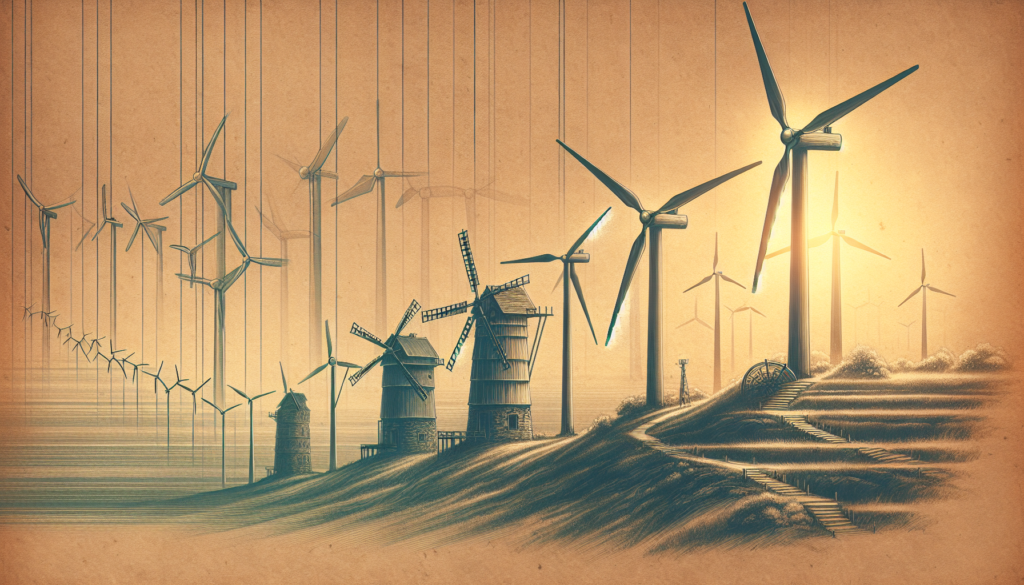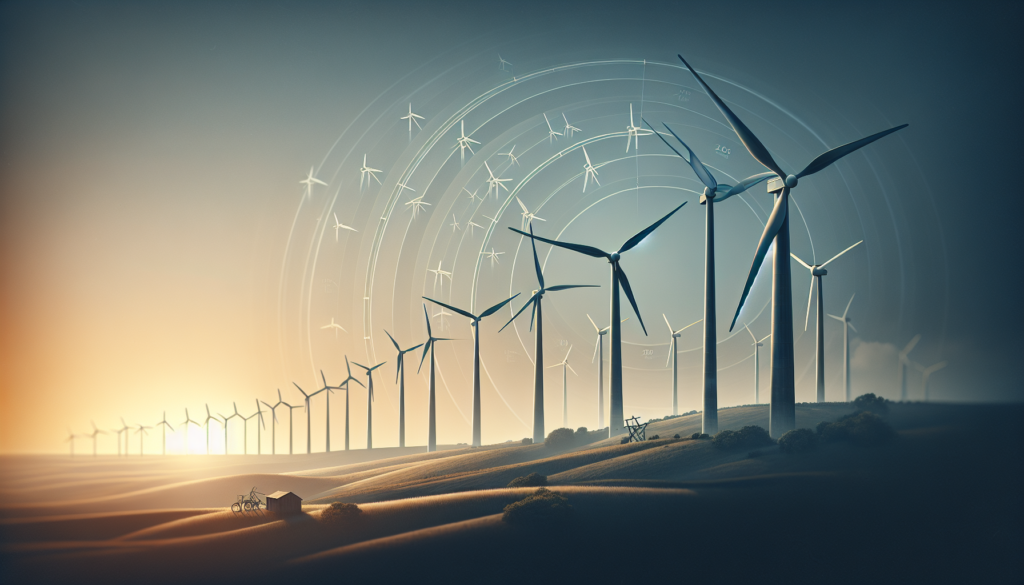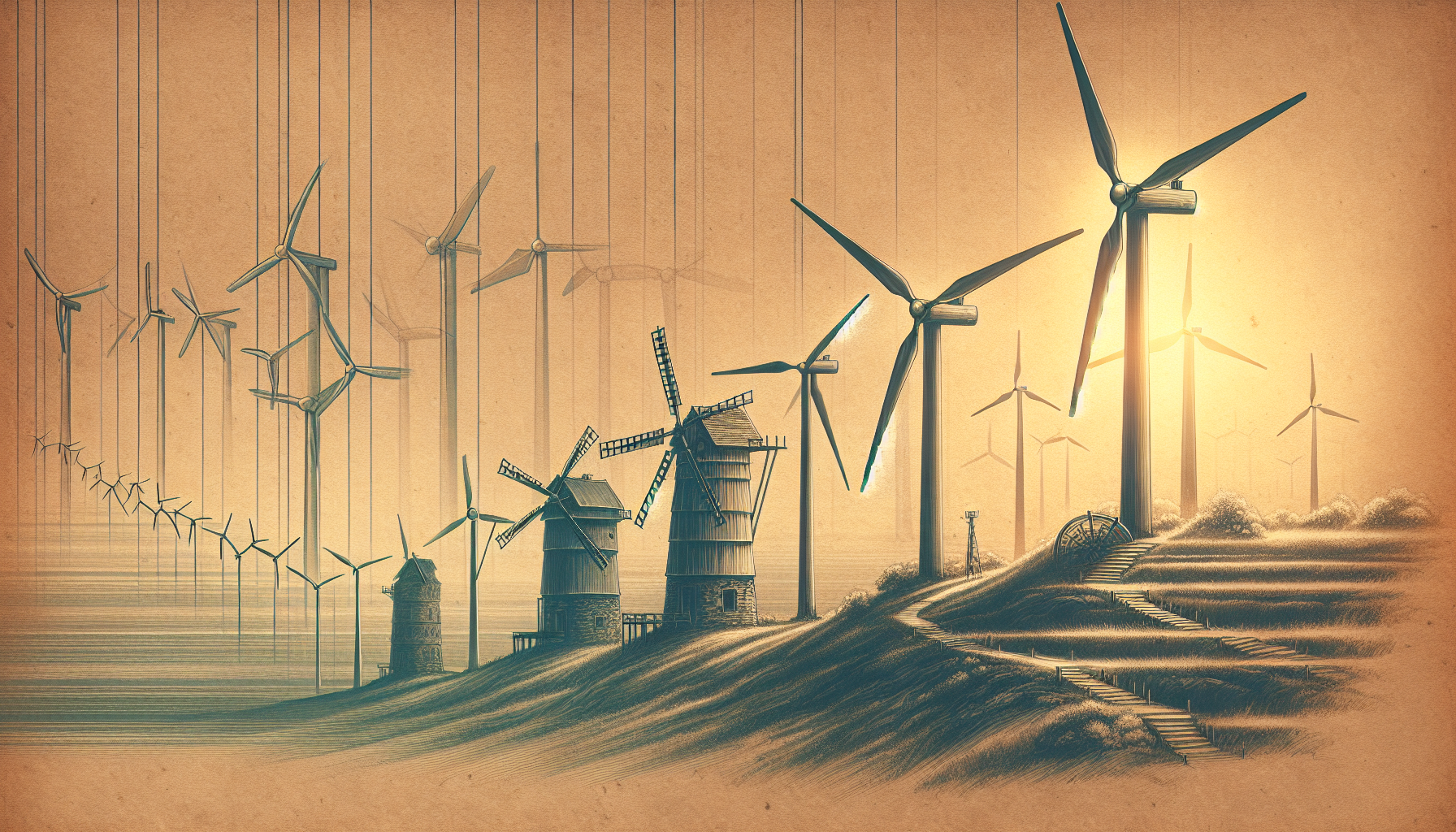Have you ever wondered how wind energy technology has advanced over the years? In this article, we will explore the fascinating evolution of wind energy technology. From the early days of simple windmills to the sophisticated and efficient wind turbines of today, you will discover the remarkable progress that has been made in harnessing the power of the wind. So, get ready to be amazed by the ingenuity and innovation behind the evolution of wind energy technology.

Early History of Wind Energy
Windmills in Ancient Times
Wind energy has been utilized by human civilizations for thousands of years. In ancient times, windmills were employed across various cultures to perform a multitude of tasks. From grinding grains to pumping water, windmills became invaluable tools for early societies. The first evidence of windmills dates back to ancient Persia, where they were erected around 200 BCE. These early windmills consisted of simple vertical structures with cloth or sail-like blades catching the wind’s power. Over time, windmill designs evolved and spread to other regions, becoming integral to the development of societies.
European Windmills
Europe became a hotbed for windmill innovation during the Middle Ages. Dutch inventors were particularly influential in refining windmill designs. The iconic Dutch windmills, with their large rotating blades, flourished in the 17th century and were used to drain water from low-lying lands, known as polders, and power various industrial processes. Windmills of this era served as precursors to the modern wind turbine, inspiring future generations to harness the power of the wind on an even greater scale.
Spread of Windmills to Other Continents
As European exploration and colonization expanded across the globe, so did the concept of wind energy. Windmills made their way to other continents, adapting to local needs and conditions. In Asia, windmills were used primarily for water pumping and irrigation systems. In the Americas, windmills were employed in grain milling, as seen in the iconic windmills of the American Midwest. The versatility and practicality of windmills gained recognition worldwide, setting the stage for the birth of the modern wind turbine.
The Modern Wind Turbine
The Birth of Wind Turbines
The birth of the modern wind turbine can be traced back to the late 19th and early 20th centuries. Pioneering inventors began to experiment with harnessing wind energy on a larger scale. Scottish engineer James Blyth is credited with the construction of the first electricity-generating wind turbine in 1887. Standing at just 10 meters tall, Blyth’s wind turbine marked the beginning of a new era in wind energy technology.
Early Design Innovations
In the mid-20th century, wind turbine technology experienced significant advancements. Danish engineers, most notably Poul la Cour, played a vital role in improving the efficiency of wind turbines. La Cour’s innovations included aerodynamic turbine designs and automatic regulation systems, increasing the performance and reliability of wind turbines. These early design innovations set the stage for further progress in the field of wind energy.
Improved Efficiency with Blade Design
One of the predominant breakthroughs in wind turbine technology was the development of advanced blade designs. The transition from cloth sails to rigid blades significantly increased the efficiency and power output of wind turbines. Aerodynamic profiles, such as the NACA airfoils, were adopted to optimize the conversion of wind energy into rotational motion. Further improvements focused on enhancing blade shape, length, and materials, resulting in higher energy capture and overall turbine performance.
Introduction of Technical Systems
The introduction of technical systems to wind turbines was another milestone in their evolution. Tower structures were refined to provide increased stability and elevated heights, allowing turbines to harness stronger and more consistent winds at higher altitudes. Electrical generators were incorporated into wind turbines to convert mechanical energy into usable electricity. Additionally, yaw control systems were developed to allow turbines to automatically face the wind, ensuring optimal wind capture and power generation.
Advancements in Wind Farm Design
Early Wind Farms
The concept of wind farms, where multiple wind turbines are installed in close proximity, emerged in the early 20th century. The Smith-Putnam wind turbine project, constructed in Vermont in 1941, is recognized as the world’s first modern wind farm. This pioneering endeavor consisted of 1.25 MW of total installed capacity, supplying power to the local utility grid. The success of such early wind farms paved the way for future developments in wind farm design.
Grid Integration
As wind farms grew in size and capacity, the need for effective integration into existing electrical grids became paramount. Advanced grid integration systems were developed to enable the seamless transmission of wind-generated electricity to consumers. New technologies, including transformers, power converters, and voltage regulation systems, were incorporated into wind farm infrastructures to ensure reliable and efficient integration into the grid. These advancements solidified the position of wind energy as a significant contributor to the global energy mix.
Offshore Wind Farms
The expansion of wind farms into offshore locations marked another significant milestone in their design and implementation. Offshore wind farms offer several advantages, including access to stronger and more consistent wind resources and reduced visual impact on land. The world’s first commercial offshore wind farm, Vindeby in Denmark, was installed in 1991 and consisted of 11 turbines. Since then, offshore wind farms have grown exponentially in scale and capacity, contributing to the overall global wind energy production.
Increased Efficiency and Power Output
The Impact of Research and Development
Continuous research and development efforts have played a crucial role in improving the efficiency and power output of wind turbines. Advancements in materials, aerodynamics, and control systems have all contributed to increasing energy capture and overall turbine performance. Through extensive testing, data analysis, and computer simulations, researchers have identified areas for improvement and developed innovative solutions to maximize the potential of wind energy.
Improved Turbine Design
Turbine design has undergone substantial improvements to enhance efficiency and power output. Larger rotor diameters, coupled with increased hub heights, have allowed turbines to capture more wind energy at higher altitudes. The introduction of variable-speed turbines, capable of adjusting rotor speeds to match wind conditions, has further optimized power generation. Additionally, the use of lightweight materials, such as carbon fiber, has resulted in stronger, more durable turbines that can withstand harsh weather conditions while maintaining excellent performance.
Enhanced Control Systems
Advanced control systems have also contributed to increased efficiency and power output. Real-time data collection and analysis allow turbines to adjust their operation based on changing environmental conditions. Pitch control mechanisms, which adjust blade angles, and yaw control systems, which ensure turbines face the wind, optimize energy capture. Additionally, the integration of smart grid technologies facilitates communication between turbines, allowing for coordinated operation and improved power flow management.

Innovations in Wind Energy Storage
Battery Systems
With the increasing penetration of wind energy into the grid, the need for energy storage solutions has become more apparent. Battery systems have emerged as a promising technology for storing wind-generated electricity. Advances in battery chemistry and design have led to increased energy density and longer lifespans, making them viable options for grid-scale energy storage. These systems enable the storage of excess wind energy during periods of low demand and release it during peak demand, improving system stability and reliability.
Hydrogen Fuel Cells
Hydrogen fuel cells offer another avenue for wind energy storage. Excess electricity generated by wind turbines can be used to electrolyze water, separating it into oxygen and hydrogen gas. The hydrogen gas can then be stored and utilized later in fuel cells to generate electricity on-demand. This conversion process provides a flexible and efficient method of energy storage, especially in situations where battery systems may not be suitable due to their limited capacity.
Compressed Air Energy Storage
Compressed air energy storage (CAES) is another innovative solution for storing wind energy. During periods of low electricity demand, surplus wind energy can be used to compress air and store it in underground caverns or tanks. When electricity demand rises, the compressed air can be released, driving turbines to generate electricity. CAES systems offer large-scale energy storage capacities and can provide grid stability during peak demand periods.
Environmental Impact and Mitigation
Assessing Environmental Effects
As wind energy continues to grow, it is essential to assess and mitigate potential environmental impacts. Environmental impact assessments (EIA) play a crucial role in identifying and addressing any adverse effects of wind farms on ecosystems. These assessments consider factors such as bird and bat collisions, noise pollution, and visual impacts. By understanding the potential impacts, appropriate mitigation measures can be implemented to minimize any negative consequences.
Bird and Bat Protection Measures
Bird and bat protection measures are essential for reducing the impact of wind turbines on avian and mammalian populations. Research has led to the implementation of various strategies to mitigate bird and bat collisions, such as optimizing turbine placement to avoid migration routes, employing radar systems to detect flying animals, and using deterrent devices, such as ultrasonic emitters or motion sensors. These measures help strike a balance between renewable energy production and wildlife conservation.
Noise Reduction Techniques
Wind turbines can generate noise, which may have implications for nearby residents. To address this concern, wind turbine manufacturers have implemented noise reduction techniques to minimize the impact on communities. These techniques include optimizing blade design, using advanced noise control materials, and implementing operational protocols to regulate noise emission levels. By prioritizing noise reduction, the wind industry seeks to ensure a positive coexistence of wind energy projects and local communities.
Wind Energy in Developing Countries
Expanding Access to Electricity
Wind energy has the potential to play a crucial role in expanding access to electricity in developing countries. Many remote regions lack reliable access to traditional power sources, such as fossil fuels or centralized grids. Wind turbines offer a decentralized and renewable energy solution that can be easily implemented in these areas. Small-scale wind systems, such as microgrids or community-owned wind farms, can provide clean electricity to communities, promoting economic growth, education, and improved quality of life.
Harnessing Local Resources
One advantage of wind energy in developing countries is the abundance of wind resources in many regions. By harnessing local wind resources, countries can reduce their dependence on imported fossil fuels and create a sustainable energy infrastructure. The development of local wind energy projects also stimulates the growth of local industries and job opportunities, contributing to economic development and reducing poverty.
Overcoming Challenges
While wind energy presents significant opportunities for developing countries, it also comes with challenges. Limited financial resources, lack of technical expertise, and inadequate infrastructure can hinder the deployment of wind energy projects. However, various initiatives, such as international collaborations, financial aid programs, and capacity building efforts, are being implemented to overcome these obstacles and support the transition to renewable energy in developing countries.
Integration of Wind Energy into the Grid
Balancing Variable Output
Wind energy is inherently variable due to the intermittent nature of wind. However, the integration of wind energy into the grid requires a reliable and stable power supply. To successfully balance variable outputs, grid operators employ various strategies. These include integrating wind energy with other renewable sources and conventional power plants, implementing energy storage systems, and utilizing advanced forecasting techniques to predict wind patterns. By efficiently managing the flow of electricity, the grid can maintain stability and ensure a continuous supply of energy to consumers.
Smart Grid Technologies
The integration of wind energy is facilitated by the adoption of smart grid technologies. Smart grids enable real-time communication between power producers, grid operators, and consumers, allowing for efficient management of electricity supply and demand. Advanced sensors, smart meters, and automation systems enable the grid to respond dynamically to changes in wind energy production and consumption patterns. This enhanced grid intelligence promotes a more reliable, resilient, and efficient energy system.
Demand Response Programs
Demand response programs are another method of integrating wind energy into the grid. These programs incentivize consumers to adjust their electricity usage based on supply-demand imbalances. By providing price signals or time-of-use rates, consumers can reduce or shift their electricity consumption during periods of high wind energy production. Demand response programs not only help manage variable wind energy output but also promote energy conservation and cost savings for consumers.
Future Prospects and Challenges
Continued Technological Advancements
The future of wind energy technology holds great potential for further advancements. Ongoing research and development efforts focus on increasing turbine efficiency, exploring new materials, and designing more intelligent control systems. Advanced computational modeling and data analytics are driving innovation, enabling the optimization of wind farm layouts, improved prediction of wind patterns, and enhanced turbine performance. Continued technological advancements will play a significant role in driving the growth and adoption of wind energy.
Integrating Wind Energy in the Energy Market
As wind energy continues to expand, integrating it into the energy market becomes increasingly important. Implementing effective policies, such as feed-in tariffs, renewable portfolio standards, and carbon pricing mechanisms, will incentivize investment in wind energy projects and ensure a fair market competition. Furthermore, establishing efficient transmission infrastructure, grid codes, and interconnection standards will facilitate the seamless integration of wind energy into the existing energy market.
Overcoming Public Perception
One of the challenges for wind energy adoption is addressing public perception and concerns. While wind turbines offer clean and renewable energy, they can face opposition due to visual impacts, noise concerns, and misconceptions about their ecological impact. It is essential to engage with communities, provide accurate information, and address concerns transparently. Collaborative efforts between policymakers, industry stakeholders, and local communities can help foster greater acceptance and understanding of wind energy.
Conclusion
The evolution of wind energy technology has been remarkable, from ancient windmills to the modern wind turbine. Early civilizations harnessed wind power for their daily needs, paving the way for advancements in Europe and the subsequent spread of windmills worldwide. Over the years, wind turbines have become more efficient, incorporating innovative designs, enhanced control systems, and increasing power output. The development of wind farms, the integration of wind energy into the grid, and the exploration of energy storage solutions have further expanded the potential of wind energy. The environmental impact has been assessed, mitigated, and efforts to expand wind energy in developing countries have been undertaken. However, challenges remain, and future prospects depend on continued technological advancements, effective market integration, and addressing public perception. With these endeavors, wind energy will continue to be a vital component of the world’s energy landscape, contributing to a sustainable and renewable future.

